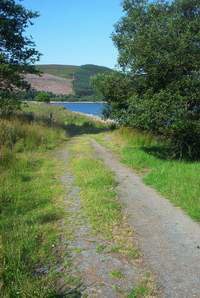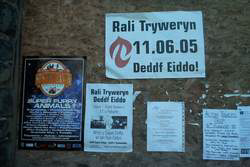Abandoned Communities ..... Reservoirs of Wales
By this time the Tryweryn Bill was making progress through parliament. There was a lengthy debate in the House of Commons on 3 July 1957, on the motion that the House should decline to give the bill a second reading. Several MPs representing Welsh constituencies spoke in favour of the motion. At the end of the debate Henry Brooke, who had the dual role of Minister of Housing and Local Government and Minister for Welsh Affairs, gave his reply. He acknowledged the widespread opposition to the bill, reporting that he had received protests from 95 local authorities, from 210 churches, trade unions, and political and voluntary organisations, and from 375 individuals. Nevertheless he felt obliged to support the bill, and amidst a good deal of derision he ended his speech by asserting that those who opposed it would be saddled with a "grave responsibility for water shortages in Merseyside and south-west Lancashire", and he could not believe that "Welsh people of all people want to stand outside the brotherhood of man to that extent."
The second reading went ahead, and then on 1 August the bill became law. All but one Welsh MP voted against it, but they formed a minority in the House of Commons as a whole. Afterwards there was much resentment against Henry Brooke, with demands that he should resign and that the post of Minister for Welsh Affairs should not be combined with another position in a way that might cause a conflict of interest. But the most significant political outcome was a widespread recognition in Wales that the country needed to become more independent, able to take responsibility for decisions that would have major implications for its people.
The building of the dam proceeded and Llyn Celyn was created. A new stretch of the main road from Bala to Ffestiniog was built to replace the section due to be submerged. The official opening took place on 28 October 1965. The early years of the 1960s were, however, marked by a trend towards more violent protests. In September 1962 two men opened the top of an oil tank on the Tryweryn dam site and released 1,000 gallons. In the small hours of 10 February 1963 a transformer supplying electricity was blown up. Soon afterwards, an attempt was made to blow up a pylon carrying power cables to the dam. At the opening ceremony several individuals wearing the uniform of the Free Wales Army staged a noisy demonstration.
The fate of the Tryweryn valley still provokes strong feelings among the people of Wales. Travelling through North Wales you will come across reminders of Tryweryn and Capel Celyn painted on bridges, large rocks, and electricity pylons. Rallies and campaigns that have other purposes related to the Welsh nationalist cause will use the name Tryweryn. In 2001 when the British Government was considering making a large financial contribution to a controversial dam in Turkey Tryweryn was chosen as the site of a protest rally.
The second reading went ahead, and then on 1 August the bill became law. All but one Welsh MP voted against it, but they formed a minority in the House of Commons as a whole. Afterwards there was much resentment against Henry Brooke, with demands that he should resign and that the post of Minister for Welsh Affairs should not be combined with another position in a way that might cause a conflict of interest. But the most significant political outcome was a widespread recognition in Wales that the country needed to become more independent, able to take responsibility for decisions that would have major implications for its people.
The building of the dam proceeded and Llyn Celyn was created. A new stretch of the main road from Bala to Ffestiniog was built to replace the section due to be submerged. The official opening took place on 28 October 1965. The early years of the 1960s were, however, marked by a trend towards more violent protests. In September 1962 two men opened the top of an oil tank on the Tryweryn dam site and released 1,000 gallons. In the small hours of 10 February 1963 a transformer supplying electricity was blown up. Soon afterwards, an attempt was made to blow up a pylon carrying power cables to the dam. At the opening ceremony several individuals wearing the uniform of the Free Wales Army staged a noisy demonstration.
The fate of the Tryweryn valley still provokes strong feelings among the people of Wales. Travelling through North Wales you will come across reminders of Tryweryn and Capel Celyn painted on bridges, large rocks, and electricity pylons. Rallies and campaigns that have other purposes related to the Welsh nationalist cause will use the name Tryweryn. In 2001 when the British Government was considering making a large financial contribution to a controversial dam in Turkey Tryweryn was chosen as the site of a protest rally.
In October 2005 the Liverpool council voted to publish an apology for the way in which the Tryweryn valley had been flooded: “For any insensitivity by our predecessor council at that time, we apologise and hope that the historic and sound relationship between Liverpool and Wales can be completely restored.”
More on the apology by Liverpool council can be found at this address.
For a spectacularly stern view of the Welsh reservoirs go to the Poetry section and read the poem by R S Thomas.
Seven
The old road from Ffestiniog to Bala, just before it enters Llyn Celyn
Cofio Celyn - remember Celyn
Part of a campaign to highlight the need for a Property Act for Wales
Cofiwch Dryweryn, by Claudia Williams
(image supplied by the Martin Tinney Gallery)



